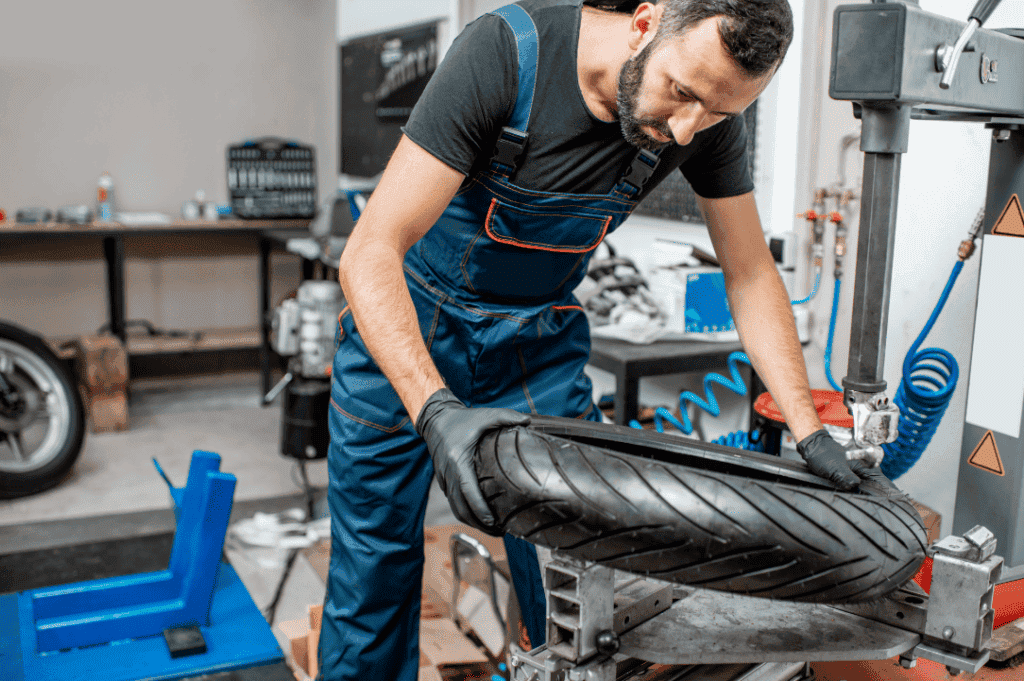
A motorcycle ride can be easily ruined when your bike is causing you discomfort. There are several ways a motorcycle can do this including emitting a vibration that’s intolerable.
Not only is a problem like this uncomfortable, but it’s also concerning and frustrating. This holds especially true when you accelerate your motorcycle and the vibration gets worse.
Why does a motorcycle vibrate when accelerating? A motorcycle that vibrates upon acceleration is usually caused by front or rear tire issues such as uneven tread, an unbalanced tire, a bent rim, or a sticking brake caliper. Other reasons may include a bent front or rear sprocket, a sticking piston, a bad crankshaft bearing, or a cylinder misfire.
Intense motorcycle vibration upon acceleration is a problem that riders shouldn’t have to tolerate. But it can be an issue that is difficult to pinpoint as to why it’s happening. This article can guide you through the possible reasons why your motorcycle is vibrating and describe helpful ways to fix it.
Why Your Motorcycle Vibrates On Acceleration

Every motorcycle will have a slight vibration to it. This is mostly because of the pistons moving up and down inside the engine. But this type of vibration is barely noticeable and should not distract you from your ride.
More noticeable vibrations on a motorcycle, especially ones that make you uncomfortable, is an indication that something on your motorcycle isn’t working right. Motorcycles sometimes vibrate during acceleration which can be concerning for the rider if they have to ride at higher speeds.
The first and likely culprit to vibration during acceleration is due to the tires and rims (either the front or the back). There are several reasons a tire and it’s rim could cause vibration, the first one being that one of the tires is unbalanced.
When a motorcycle tire is unbalanced, that means on side is heavier than the other side. So instead of delivering an even and smooth ride, the tire bounces from side to side very quickly the faster you go which will turn into a vibration.
Uneven tread on the tire can also cause vibration upon acceleration. This is usually caused by the tire being unbalanced but other reasons may be the culprit (such as being dragged, etc.). An uneven tire tread would also make the tire bounce from side to side which exacerbates upon acceleration.
Inspect the rims on your tires and make sure there aren’t any dents or bends. Even the smallest of dents can cause a slew of problems and will likely manifest itself when going higher speeds on your motorcycle.
A sticking brake caliper may also be your problem. The brakes will not release if you have a sticky brake caliper which will cause the brake rotors to become overheated and ultimately warp. The faster you go on your motorcycle, the hotter the rotors will get and become more warped which will emit an intense vibration.
If you sense the vibration upon acceleration is coming more from the back half of the motorcycle but know it isn’t the tire or caliper, a possible cause could be from a bent front or rear sprocket. The sprocket is what rotates the chain and delivers power to the back tire. If either one of those are bent, higher speeds will manifest a vibration because the bend is causing the chain to move from side to side which is a motion that will be delivered to the back tire.
If you’ve noticed the vibration coming more from the center of the motorcycle, it’s likely an issue inside the engine. Noticeable and uncomfortable vibrations from the engine can be caused by a sticking piston, a bad crankshaft bearing, or a cylinder misfire. All of these issues cause a vibration because of the disturbed momentum coming from the motion of the pistons.
Acceleration makes the problems worse because the engine is working harder; the disturbance becomes more noticeable and manifests itself through a rough vibration.
How To Make Your Motorcycle Run Smoother

If you’ve ever ridden your motorcycle with that uncomfortable vibration, you’ll know you don’t want to ride like that any longer and need to address the issue as soon as possible. As you can see, the reasons for vibration is underlying issues that should be addressed anyway whether or not it causes a vibration. They all can lead to serious malfunctions later on.
First, let’s discuss vibration issues caused by the tires. Inspect both the front and back tires and rims. Notice the tread on them and freely spin them (while the motorcycle is off) and see if you notice a wobble at all. Any uneven wear on the tire means you’ll need to replace it. The good thing about that is you don’t have to replace both tires at the same time on a motorcycle.
If there is a noticeable wobble, you’ll need to take your bike into a shop and have them balance the tire for you. They have the large equipment that can easily get this job done and is fairly inexpensive, usually around $40.
It’s important to note that if you have found a bent rim, you’ll either need to have a professional fix it or simply get a new one. Bent rims are not a DIY project because the consequences are pretty severe if it’s done wrong. For more information about bent rims, see my other article here.
If you’ve freely rotated either tire and notice one or both of the tires has difficulty spinning accompanied by a metal sliding sound, one of the brake calipers is likely sticking. This is usually caused by rust or another type of grime building up on the side of the caliper piston. Luckily this is a fairly easy fix. They’re also not too expensive if you simply want to replace them with the average cost ranging from $30-$50.
To repair the calipers, you’ll need to remove them from the disc. Make sure the master cylinder is topped off with brake fluid so you don’t risk getting any air bubbles in the braking system. Pump the break lever to get the pistons to push out (but not so far that they come out completely). Peel the boots back a little bit and clean it up so it stops sticking. Use a c-clamp to push the piston back in and replace the brake caliper; test it to make sure it isn’t sticking anymore.
If you have a bent front or rear sprocket, that’s something you should replace. Getting those perfectly straight again can be difficult and often results in warping it even more.
A vibration caused by engine issues can be a little more tricky to fix. You can first start by assuming your engine is misfiring which can be caused by premature detonation. This will often be accompanied by a knocking sound (click here to see my article about why an engine knocks). Spark plugs are a common culprit, so changing those out and/or adjusting the gap at the tip may resolve that.
A sticking piston, which can be caused by despot build up inside the cylinder walls, will need to be addressed by an mechanic. A bad crankshaft bearing will also need attention from a professional unless you have experience rebuilding an engine.
Why Motorcycle Vibration Should Be Promptly Addressed
The intense vibration of a motorcycle is an issue that isn’t simply going to just go away. It will only get worse over time and could end in catastrophic situations if not addressed.
The very beginning of the noticeable vibration upon acceleration may be hard to pinpoint, but that’s not to say you should wait until it gets worse to know exactly where it’s coming from. When a damaged tire or rim are continuously used, the tire could ultimately blow while out for a ride. This can result in an accident if the rider doesn’t know how to handle this. See my article here to learn more about what to do when your motorcycle tire blows.
If you continue riding a motorcycle with vibrations caused by engine issues, you risk the engine becoming seized. That’s an expensive fix and you may need to replace the engine altogether if you let it get to that point.
Aside from the mechanical issues, riding on a motorcycle that’s vibrating is extremely uncomfortable. It can make a rider’s hands, feet, legs, and butt go numb. Since your feet and hands are the ones operating the vehicle, having them numb isn’t something you’ll want to experience while on a ride.

